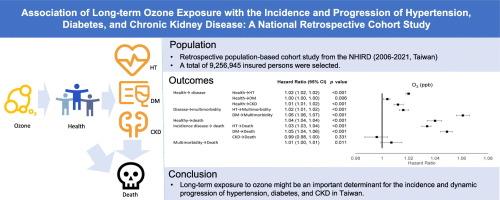长期臭氧暴露与高血压、糖尿病和慢性肾脏疾病的发病率和进展的关系:一项全国回顾性队列研究
IF 8
1区 环境科学与生态学
Q1 ENVIRONMENTAL SCIENCES
引用次数: 0
摘要
有证据表明,臭氧与高血压、糖尿病或慢性肾脏疾病(CKD)的风险增加有关。然而,臭氧暴露与亚洲人群中这些疾病的动态进展之间的关系仍然未知。该研究包括2006年至2021年间来自台湾全民健康保险研究数据库的9,256,945名参与者。多重发病定义为CKD与高血压或糖尿病共存。用普通克里格法估计臭氧、二氧化硫、一氧化碳、二氧化氮、悬浮细颗粒物和悬浮颗粒物的日浓度。然后,计算出污染物的五年平均浓度。我们建立了多状态生存模型来分析臭氧与这些疾病动态进展之间的关系。在随访期间,3,555,498名参与者经历了高血压、糖尿病或CKD;多重发病656515例;792555人死亡。臭氧暴露与所有过渡中结果的发生率显著相关。臭氧每增加一个IQR (3.57 ppb),向发病过渡的风险比为1.016[95%可信区间(CI): 1.014, 1.017],向死亡过渡的风险比为1.04 [95% CI: 1.036, 1.043],向多病过渡的风险比为1.015 [95% CI: 1.012, 1.017]。臭氧浓度每增加1个IQR,由发病向死亡过渡的风险比为1.03 [95% CI: 1.026、1.033],由多发病向死亡过渡的风险比为1.007 [95% CI: 1.002、1.013]。我们的研究结果表明,长期暴露于臭氧可能是台湾高血压、糖尿病和CKD发病率和动态进展的重要决定因素。本文章由计算机程序翻译,如有差异,请以英文原文为准。

Association of long-term ozone exposure with the incidence and progression of hypertension, diabetes, and chronic kidney disease: A national retrospective cohort study
Evidence suggests that ozone is associated with an increased risk of hypertension, diabetes, or chronic kidney disease (CKD). However, the associations of ozone exposure with the dynamic progression of these diseases among Asian population remain unknown.
This study included 9,256,945 participants from Taiwan's National Health Insurance Research Database between 2006 and 2021. Multimorbidity was defined as the coexistence of CKD and either hypertension or diabetes. The ordinary kriging method was used to estimate daily concentrations of ozone, sulfur dioxide, carbon monoxide, nitrogen dioxide, suspended fine particles, and suspended particles. Then, five-year average concentrations of pollutants were calculated. We performed multi-state survival models to analyze the association between ozone and dynamic progression of these diseases.
During follow-up, 3,555,498 participants experienced hypertension, diabetes, or CKD; 656,515 experienced multimorbidity; and 792,555 died. Ozone exposure was significantly associated with incidence of the results in all transitions. The hazard ratios of each IQR (3.57 ppb) increment in ozone for the transition to incident disease were 1.016 [95 % confidence interval (CI): 1.014, 1.017], for the transition to death were 1.04 [95 % CI: 1.036, 1.043], for the transition to multimorbidity were 1.015 [95 % CI: 1.012, 1.017]. Furthermore, with each IQR increase of ozone, the hazard ratios for transition from the disease incidence to death and from multimorbidity to death were 1.03 [95 % CI: 1.026, 1.033] and 1.007 [95 % CI: 1.002, 1.013], respectively.
Our results suggest long-term exposure to ozone might be an important determinant for the incidence and dynamic progression of hypertension, diabetes, and CKD in Taiwan.
求助全文
通过发布文献求助,成功后即可免费获取论文全文。
去求助
来源期刊

Science of the Total Environment
环境科学-环境科学
CiteScore
17.60
自引率
10.20%
发文量
8726
审稿时长
2.4 months
期刊介绍:
The Science of the Total Environment is an international journal dedicated to scientific research on the environment and its interaction with humanity. It covers a wide range of disciplines and seeks to publish innovative, hypothesis-driven, and impactful research that explores the entire environment, including the atmosphere, lithosphere, hydrosphere, biosphere, and anthroposphere.
The journal's updated Aims & Scope emphasizes the importance of interdisciplinary environmental research with broad impact. Priority is given to studies that advance fundamental understanding and explore the interconnectedness of multiple environmental spheres. Field studies are preferred, while laboratory experiments must demonstrate significant methodological advancements or mechanistic insights with direct relevance to the environment.
 求助内容:
求助内容: 应助结果提醒方式:
应助结果提醒方式:


